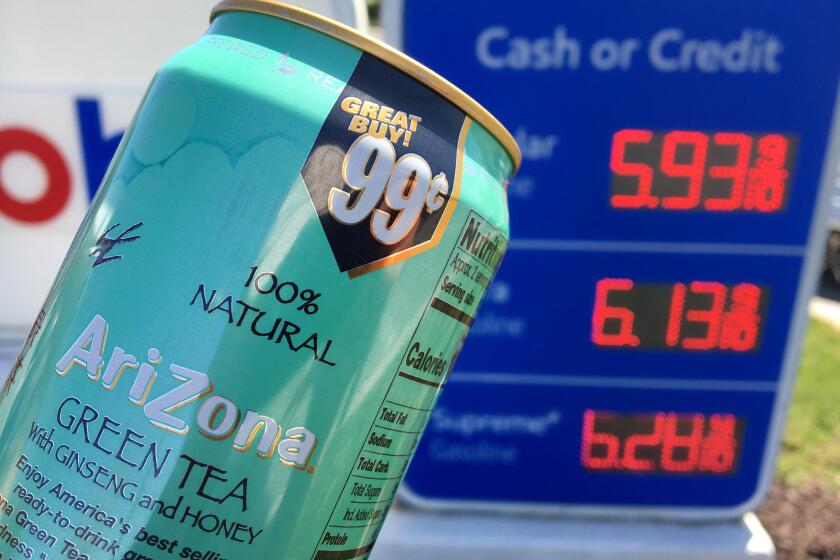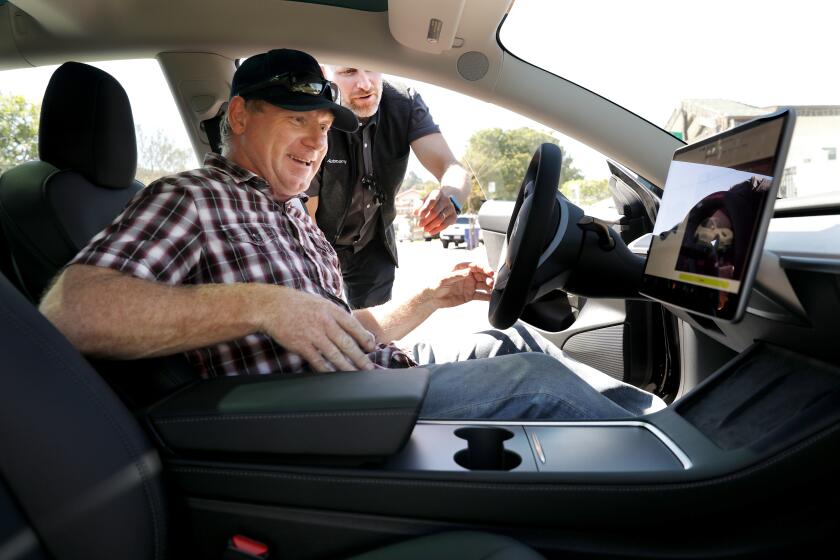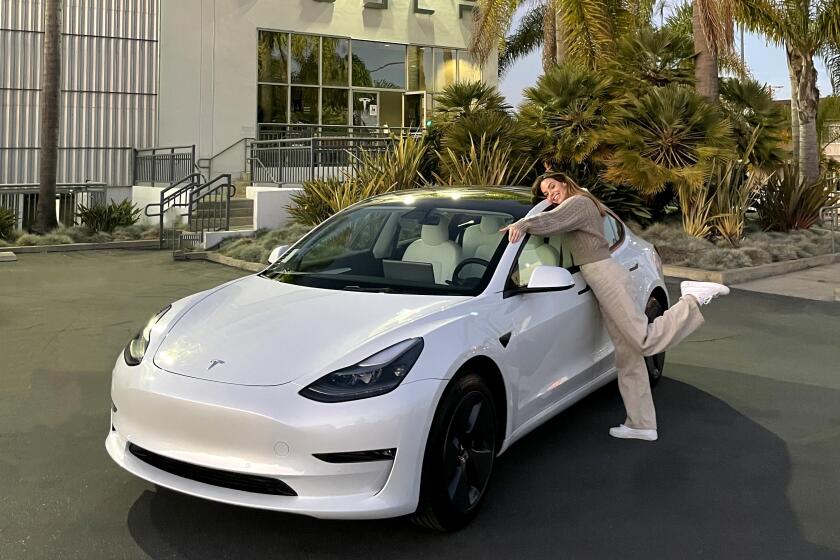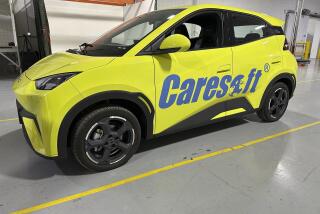Modest-income buyers being priced out of the new-vehicle market
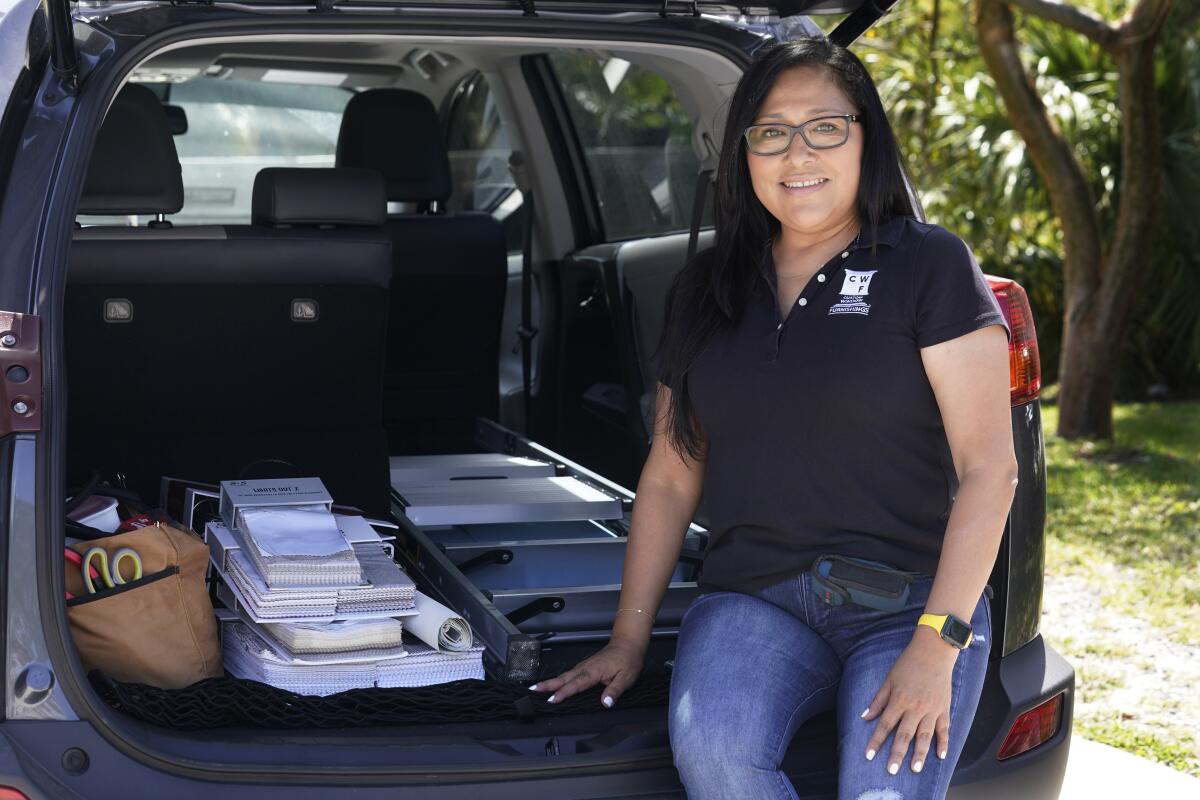
- Share via
DETROIT — Two years after the pandemic tore through the economy, America’s auto market looks something like this: Prices are drastically up. Supply is drastically down. And gasoline costs drastically more.
The result? A widening disparity between the richest buyers and everyone else.
The most affluent buyers keep plunking down big money for new vehicles, including the least fuel-efficient among them — trucks, SUVS, large sedans.
As for the rest of America, millions are feeling increasingly priced out of the new-vehicle market. They are competing instead for a shrunken supply of used autos, especially smaller, less expensive ones that consume less fuel. The jump in pump prices since Russia’s invasion of Ukraine has only intensified their urge to keep costs down.
They are people like Natalia Ponce De Leon of North Palm Beach, Fla. She had been leasing a Toyota Tacoma pickup she acquired as new four years ago and had been using for her custom drapery business. When it was time to replace it recently, she didn’t even consider a new vehicle.
Instead, she settled on a 9-year-old vehicle with 14,000 miles on it — a Toyota RAV4, a small SUV, that she bought at Earl Stewart Toyota in North Palm Beach. Though it cost her $23,000 to buy the SUV and pay off the remainder of her lease, Ponce De Leon is happy with her decision. For just under $400 a month for six years, she said, she has a vehicle that’s easier to drive than her old pickup yet spacious enough to carry a 6-foot ladder for her business.
Tall cans of AriZona iced tea have cost 99 cents since 1992. The family behind the company says it’s committed to that price even as the prices of aluminum and corn syrup climb higher.
Best of all, with gasoline having scaled $4 a gallon nationally, she’s enjoying superior fuel efficiency.
“I’m thinking I’m going to save, per month, between $100 and $200,” Ponce De Leon said — money that she plans to spend for online marketing to help grow her business.
The new-vehicle market is another story entirely. Among all purchases of new autos last month, nearly 79% were trucks and SUVs. A decade ago, that proportion was just 52%.
And that’s despite a whopping 22% jump in the average price of a new car since the pandemic struck two years ago — to more than $46,000, as of December.
Based on March prices and interest rates, the monthly payment on an average new vehicle would be $691 — far beyond the reach of what a household with a median gross income of $65,732 should spend, according to calculations by Cox Automotive and Moody’s.
Not so for many of the wealthier-than-average buyers who now dominate the new-vehicle market.
“Those that can afford it are still buying what they want,” said Jeff Schuster, president of global forecasting for LMC Automotive, a consulting firm.
Despite high gas prices, a vehicle shortage is putting the brakes on what should be an EV boom and pushing buyers to search for workarounds.
Ivan Drury, a senior manager at the Edmunds.com auto site, has been surprised by the demand among affluent buyers for high-priced new vehicles.
“I can’t imagine a situation in which we’ve had so many people willing to spend so much money,” Drury said. “It’s just abnormal for someone to go out and spend [sticker price] or above. I can’t think of any other time period unless it was on specific models. And this is every car on the road.”
Left largely out of that pool, buyers of more modest means have been vying for the most fuel-efficient used vehicles — and forcing up their prices. At auctions where dealers buy many of their vehicles, the average price of a 2- to 8-year-old compact car rose 1.1% during the past three weeks to an average of $12,560. That’s an annual rate of nearly 20%. The price of older cars is up even more, according to data compiled by Black Book, which monitors such prices.
By contrast, over the same period, the average for a full-size 2- to 8-year-old SUV actually fell 2.3%, to $32,700.
“The demand is pushing dealers to buy smaller, more efficient, and older vehicles,” said Alex Yurchenko, chief data officer for Black Book.
Behind that trend lies an economic reality: Americans as a whole have less cash to spend. Although America’s job market is robust and many people have received pay raises in recent months, the acceleration of inflation has more than wiped out those gains in most cases.
High gas prices are making life difficult for many drivers. But some people aren’t bothered, mainly because they switched to other modes of transportation.
Consumer prices have skyrocketed 8.5% over the past year, the fastest such pace in four decades. In addition, stimulus checks and other federal aid that most households received after the pandemic have long since expired.
In many cases, too, households have drawn down much of the cash they had stockpiled during the pandemic. In response, Americans as a whole are going deeper into debt to pay their expenses.
“People in the lower price range are just jammed up,” Drury noted. “It’s weird to have so many people with so much money, and we have this other swath of consumers that say, ‘I’m tapped out.’ ”
Further stressing the lower-priced market is the shrinking availability of leasing, which had long allowed ordinary households to keep monthly payments low. Leasing has nearly dried up because automakers are no longer offering attractive deals.
“They don’t have to,” said Jonathan Smoke, chief economist of Cox Automotive, “because [auto] supplies are low.”
Even among higher-income households, the run-up in gas prices has left more buyers focused on fuel efficiency. In particular, many have been snapping up electric vehicles, whose sales jumped 66% over the past year, Edmunds.com says. Even so, the EV share of the overall auto market remains only about 4%.
In the meantime, prices for both new and used vehicles have begun to fall or level off. From February to March, average prices for used cars and trucks actually fell nearly 4%. That may suggest, Drury said, that people have had it and won’t keep paying inflated prices. Automakers have even begun to raise discounts on pickup trucks.
“They might have tapped out of consumers that pay any price to get what they want,” Drury said.
More to Read
Inside the business of entertainment
The Wide Shot brings you news, analysis and insights on everything from streaming wars to production — and what it all means for the future.
You may occasionally receive promotional content from the Los Angeles Times.
